译者的话
后备母猪的初配日龄、体况、情期要求在业界已有广泛的共识,但第一胎母猪在哺乳期内是应该失重还是增重存在不同的看法,本研究从统计学的角度分析得出:从第一次授精到哺乳期间母猪增重越多,其受孕失败的比例就越低,且此期间增重情况会影响第二胎的繁殖性能--增加第一次配种以及哺乳期的体重可以优化第二胎的繁殖性能。详尽内容,请观《一胎母猪的增重及繁殖情况对其二胎繁殖性能的影响》。
一胎母猪的增重及繁殖情况对其二胎繁殖性能的影响(中)
Effect of live weight development and reproduction in first parity on reproductive performance of second parity sows - Part 2
L.L. Hovinga,b,∗, N.M. Soedea, E.A.M. Graatc, H. Feitsmad, B. Kempa
a 荷兰瓦赫宁根大学瓦赫宁根动物科学研究所(WIAS)适应生理学组
a Adaptation Physiology Group, Wageningen Institute of Animal Sciences (WIAS), Wageningen University, The Netherlands
b 荷兰Varkens KI Nederland公司
b Varkens KI Nederland, The Netherlands
c 荷兰瓦赫宁根大学WIAS定量兽医流行病学小组
c Quantitative Veterinary Epidemiology Group, WIAS, Wageningen University, The Netherlands
d 荷兰猪遗传研究所(IPG)
d Institute for Pig Genetics (IPG), The Netherlands
关键词 Keywords:
窝产仔数 Litter size
受胎率 Pregnancy rate
繁殖性能 Reproductive performance
母猪 Sows
二胎母猪 Second parity
接上文...
3
结果 Results
3.1. 对母猪增重的测定
Measures of sow development
两个场的母猪体重增加情况差异显著(P<0.05,表2),因此分别进行分析。A场的初配日龄比B场小46天,初配体重比B场低21.3公斤。第一次分娩后和第一次断奶后,A场的母猪体重任然较轻。但是体重差异从初配时的21.3公斤减少到断奶时的9.5公斤。A猪场和B猪场在哺乳期的绝对体重和相对体重损失情况相似(A场分别为24.9 kg和13.6%;B场为23.7 kg和12.3%)。平均而言,A场母猪从初配到第一次断奶期间体重增加比B场母猪多(A场31.6 kg,B猪场20.9 kg;P<0.05)。
Farms differed significantly in sow live weight development (P<0.05, Table 2) and were therefore analyzed separately. Age and weight at first insemination were 46 days and 21.3 kg lower at farm A compared with farm B. After first farrowing and at first weaning sows on farm A remained lighter, but the weight difference was reduced from 21.3 kg at first insemination to 9.5 kg at first weaning. Both absolute and relative weight loss during lactation, was similar for farm A (24.9 kg and 13.6%) and farm B (23.7 kg and 12.3%).On average, sows on farm A gained more weight in the period between first insemination and first weaning compared with farm B (31.6 kg for farm A, 20.9 kg for farm B; P<0.05).
表2:两个猪场的母猪从第一次配种到第一次断奶的增重情况的测定。
Table 2: Measures of sow development from first insemination to first weaning on two farms.
后备母猪的初配日龄、体况、情期要求在业界已有广泛的共识,但第一胎母猪在哺乳期内是应该失重还是增重存在不同的看法,本研究从统计学的角度分析得出:从第一次授精到哺乳期间母猪增重越多,其受孕失败的比例就越低,且此期间增重情况会影响第二胎的繁殖性能--增加第一次配种以及哺乳期的体重可以优化第二胎的繁殖性能。详尽内容,请观《一胎母猪的增重及繁殖情况对其二胎繁殖性能的影响》。
一胎母猪的增重及繁殖情况对其二胎繁殖性能的影响(中)
Effect of live weight development and reproduction in first parity on reproductive performance of second parity sows - Part 2
L.L. Hovinga,b,∗, N.M. Soedea, E.A.M. Graatc, H. Feitsmad, B. Kempa
a 荷兰瓦赫宁根大学瓦赫宁根动物科学研究所(WIAS)适应生理学组
a Adaptation Physiology Group, Wageningen Institute of Animal Sciences (WIAS), Wageningen University, The Netherlands
b 荷兰Varkens KI Nederland公司
b Varkens KI Nederland, The Netherlands
c 荷兰瓦赫宁根大学WIAS定量兽医流行病学小组
c Quantitative Veterinary Epidemiology Group, WIAS, Wageningen University, The Netherlands
d 荷兰猪遗传研究所(IPG)
d Institute for Pig Genetics (IPG), The Netherlands
关键词 Keywords:
窝产仔数 Litter size
受胎率 Pregnancy rate
繁殖性能 Reproductive performance
母猪 Sows
二胎母猪 Second parity
接上文...
3
结果 Results
3.1. 对母猪增重的测定
Measures of sow development
两个场的母猪体重增加情况差异显著(P<0.05,表2),因此分别进行分析。A场的初配日龄比B场小46天,初配体重比B场低21.3公斤。第一次分娩后和第一次断奶后,A场的母猪体重任然较轻。但是体重差异从初配时的21.3公斤减少到断奶时的9.5公斤。A猪场和B猪场在哺乳期的绝对体重和相对体重损失情况相似(A场分别为24.9 kg和13.6%;B场为23.7 kg和12.3%)。平均而言,A场母猪从初配到第一次断奶期间体重增加比B场母猪多(A场31.6 kg,B猪场20.9 kg;P<0.05)。
Farms differed significantly in sow live weight development (P<0.05, Table 2) and were therefore analyzed separately. Age and weight at first insemination were 46 days and 21.3 kg lower at farm A compared with farm B. After first farrowing and at first weaning sows on farm A remained lighter, but the weight difference was reduced from 21.3 kg at first insemination to 9.5 kg at first weaning. Both absolute and relative weight loss during lactation, was similar for farm A (24.9 kg and 13.6%) and farm B (23.7 kg and 12.3%).On average, sows on farm A gained more weight in the period between first insemination and first weaning compared with farm B (31.6 kg for farm A, 20.9 kg for farm B; P<0.05).
表2:两个猪场的母猪从第一次配种到第一次断奶的增重情况的测定。
Table 2: Measures of sow development from first insemination to first weaning on two farms.
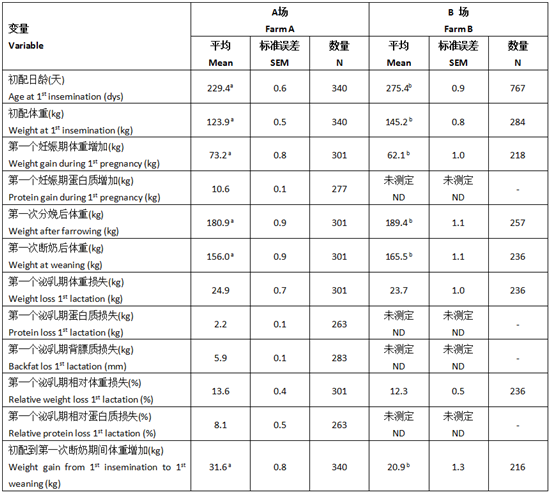
a, b行内不同上标表示差异显著(P < 0.05)。
a,b Different superscripts within rows indicate significant differences (P < 0.05);
ND:未测定
ND= not determined.
3
结果 Results
3.2. 繁殖性能的测定
Reproduction measurements
表3显示了每个猪场前两胎的繁殖结果。两场的第一胎和第二胎的受胎率没有差别。A场两胎的受胎率是相似的,分别为88.5和88.7%。而B场,第2胎的受胎率则比第一胎降低了4.2% (P < 0.05) (84.2% vs 88.4%)。
Table 3 shows reproduction results for the first two parities per farm. Pregnancy rates of first and second parity did not differ between farms. On farm A pregnancy rate was similar for both parities (resp. 88.5 vs. 88.7% for parities 1 and 2).On farm B, however, pregnancy rate of second parity was 4.2% lower (P < 0.05) compared with first parity (84.2% vs. 88.4%).
表 3:一胎和二胎母猪的繁殖结果。
Table 3: Reproduction results of first and second parity sows.
a,b Different superscripts within rows indicate significant differences (P < 0.05);
ND:未测定
ND= not determined.
3
结果 Results
3.2. 繁殖性能的测定
Reproduction measurements
表3显示了每个猪场前两胎的繁殖结果。两场的第一胎和第二胎的受胎率没有差别。A场两胎的受胎率是相似的,分别为88.5和88.7%。而B场,第2胎的受胎率则比第一胎降低了4.2% (P < 0.05) (84.2% vs 88.4%)。
Table 3 shows reproduction results for the first two parities per farm. Pregnancy rates of first and second parity did not differ between farms. On farm A pregnancy rate was similar for both parities (resp. 88.5 vs. 88.7% for parities 1 and 2).On farm B, however, pregnancy rate of second parity was 4.2% lower (P < 0.05) compared with first parity (84.2% vs. 88.4%).
表 3:一胎和二胎母猪的繁殖结果。
Table 3: Reproduction results of first and second parity sows.
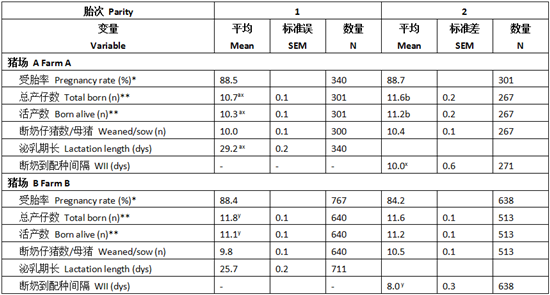
a,b 行内不同的上标表示显著差异(P < 0.05);x,y列内不同上标表示猪场间差异显著(P < 0.05)。
a,b Different superscripts within rows indicate significantly differences (P < 0.05); x,y different superscripts within columns indicate significantly differences between farms (P < 0.05).
*只在B场1胎和2胎母猪之间显著。
* Only significant between parity 1 and 2 on farm B.
**从第一次配种开始。
** From 1st insemination.
A场母猪1胎总产仔数比B场少1.1头(10.7 vs.11.8,P < 0.05),而两场的二胎母猪总产仔数无差异(均为11.6)。A场母猪2胎总产仔数比1胎高0.9头11.6 vs. 10.7,P < 0.05),而B场1胎和2胎的总产仔数没有显著差异(11.6和11.8)。
Total number born in first parity sows was 1.1 piglet lower (P < 0.05) for farm A compared with farm B (10.7 vs.11.8), whilst total number born in second parity did not differ between farms (both 11.6). On farm A total number born was 0.9 piglet higher (P < 0.05) in second parity compared with first parity sows (11.6 vs. 10.7). On farm B total number born did not significantly differ between second and first parity (11.6 and 11.8).
第一胎和第二胎断奶仔猪的数量在不同的胎次和不同的猪场之间都没有差异。A场的断奶至配种间隔比B场多2天,两场分别为8天和10天(P < 0.05)。
Number of piglets weaned in first and second parity did not differ between or within farms. Weaning to insemination interval was 2 days longer (P < 0.05) on farm A compared with farm B, respectively 8 and 10 days.
3
结果 Results
3.3. 造成受孕失败的因素
Factors associated with non-pregnancy
A场发现母猪的妊娠失败与体重变化情况有关(表4),而B场则与其他变量有关(表5)。
For farm A, measures of sow live weight development were associated with non-pregnancy (Table 4), whilst other variables were associated with non-pregnancy on farm B (Table 5).
表 4:A场二胎母猪妊娠失败相关变量的单变量比值比。
Table 4: Univariable odds ratios for variables associated with non-pregnancy in second parity sows of farm A.
a,b Different superscripts within rows indicate significantly differences (P < 0.05); x,y different superscripts within columns indicate significantly differences between farms (P < 0.05).
*只在B场1胎和2胎母猪之间显著。
* Only significant between parity 1 and 2 on farm B.
**从第一次配种开始。
** From 1st insemination.
A场母猪1胎总产仔数比B场少1.1头(10.7 vs.11.8,P < 0.05),而两场的二胎母猪总产仔数无差异(均为11.6)。A场母猪2胎总产仔数比1胎高0.9头11.6 vs. 10.7,P < 0.05),而B场1胎和2胎的总产仔数没有显著差异(11.6和11.8)。
Total number born in first parity sows was 1.1 piglet lower (P < 0.05) for farm A compared with farm B (10.7 vs.11.8), whilst total number born in second parity did not differ between farms (both 11.6). On farm A total number born was 0.9 piglet higher (P < 0.05) in second parity compared with first parity sows (11.6 vs. 10.7). On farm B total number born did not significantly differ between second and first parity (11.6 and 11.8).
第一胎和第二胎断奶仔猪的数量在不同的胎次和不同的猪场之间都没有差异。A场的断奶至配种间隔比B场多2天,两场分别为8天和10天(P < 0.05)。
Number of piglets weaned in first and second parity did not differ between or within farms. Weaning to insemination interval was 2 days longer (P < 0.05) on farm A compared with farm B, respectively 8 and 10 days.
3
结果 Results
3.3. 造成受孕失败的因素
Factors associated with non-pregnancy
A场发现母猪的妊娠失败与体重变化情况有关(表4),而B场则与其他变量有关(表5)。
For farm A, measures of sow live weight development were associated with non-pregnancy (Table 4), whilst other variables were associated with non-pregnancy on farm B (Table 5).
表 4:A场二胎母猪妊娠失败相关变量的单变量比值比。
Table 4: Univariable odds ratios for variables associated with non-pregnancy in second parity sows of farm A.
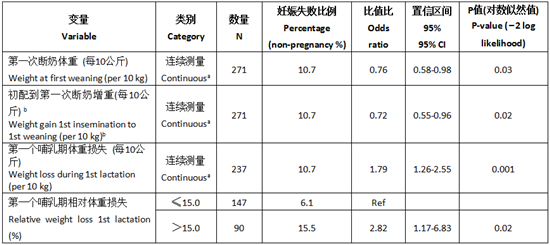
a 每个变量的均值见表1。
a For mean per variable see Table 1.
b 在多元回归后仍然显著的变量。
b Variable that remained significant after multivariable regression.
表 5:B场二胎母猪妊娠失败相关变量的单变量比值比。
Table 5: Univariable odds ratios of variables associated with non-pregnancy in second parity sow of farm B.
a For mean per variable see Table 1.
b 在多元回归后仍然显著的变量。
b Variable that remained significant after multivariable regression.
表 5:B场二胎母猪妊娠失败相关变量的单变量比值比。
Table 5: Univariable odds ratios of variables associated with non-pregnancy in second parity sow of farm B.
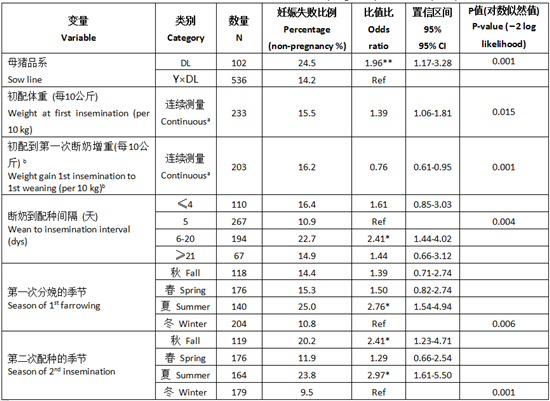
a 每个变量的均值见表1。
a For mean per variable see Table 1.
b 在多元回归后仍然显著的变量。
b Variable that remained significant after multivariable regression.
两个猪场都发现从初配到第一次断奶期间体重的增加可使妊娠失败比例下降,即受胎率增加。在初配到第一次断奶之间,体重每增加10公斤,两个场的妊娠失败比例都会下降(A场OR= 0.72 (P = 0.02),B场OR= 0.76 (P = 0.001))。图1显示了如何解读连续解释变量的OR,即从初配到第一次断奶期间每增加10公斤体重的OR。它显示了每增加一单位体重(10公斤),妊娠失败的比例降低了多少。以A场为例,母猪体重增重20公斤与增重30公斤的妊娠失败比例差异为3.4%(分别为15.7%和12.3%)。如果增重从20公斤增加到50公斤,妊娠失败比例从15.7下降到7.4%。
For both farms, weight gain from first insemination to first weaning was associated with a decreased percentage of non-pregnancy, i.e. an increased pregnancy rate. Each 10 kg increase in weight gain between first insemination and first weaning decreased the percentage of non-pregnancy on both farms (OR = 0.72 for farm A (P = 0.02) and OR= 0.76 for farm B (P = 0.001)). To visualize this, Fig. 1 shows how to interpret an OR of a continuous explanatory variable, in this case the OR per 10 kg weight gain from first insemination to first weaning. It shows how much the percentage of nonpregnancy decreases per unit of weight gain. For example farm A, the difference in percentage of non-pregnancy for sows that gain 20 kg compared to sows that gain 30 kg is 3.4% (15.7% vs. 12.3% non-pregnancy, respectively). If the weight gain increases from 20 to 50 kg, the percentage of non-pregnancy decreases from 15.7 to 7.4%.
图1:从初配到第一次断奶期间体重增加与妊娠失败比例之间的关系(逻辑回归估计,每个标记表示约30头母猪的观察值)。(L.L. Hoving et al. / Animal Reproduction Science 122 (2010) 82–89).
Fig. 1. Relation between weight gain from first insemination to first weaning and probability of non-pregnancy (lines are estimated by logistic regression, each marker represents observed values of about 30 sows). (L.L. Hoving et al. / Animal Reproduction Science 122 (2010) 82–89).
a For mean per variable see Table 1.
b 在多元回归后仍然显著的变量。
b Variable that remained significant after multivariable regression.
两个猪场都发现从初配到第一次断奶期间体重的增加可使妊娠失败比例下降,即受胎率增加。在初配到第一次断奶之间,体重每增加10公斤,两个场的妊娠失败比例都会下降(A场OR= 0.72 (P = 0.02),B场OR= 0.76 (P = 0.001))。图1显示了如何解读连续解释变量的OR,即从初配到第一次断奶期间每增加10公斤体重的OR。它显示了每增加一单位体重(10公斤),妊娠失败的比例降低了多少。以A场为例,母猪体重增重20公斤与增重30公斤的妊娠失败比例差异为3.4%(分别为15.7%和12.3%)。如果增重从20公斤增加到50公斤,妊娠失败比例从15.7下降到7.4%。
For both farms, weight gain from first insemination to first weaning was associated with a decreased percentage of non-pregnancy, i.e. an increased pregnancy rate. Each 10 kg increase in weight gain between first insemination and first weaning decreased the percentage of non-pregnancy on both farms (OR = 0.72 for farm A (P = 0.02) and OR= 0.76 for farm B (P = 0.001)). To visualize this, Fig. 1 shows how to interpret an OR of a continuous explanatory variable, in this case the OR per 10 kg weight gain from first insemination to first weaning. It shows how much the percentage of nonpregnancy decreases per unit of weight gain. For example farm A, the difference in percentage of non-pregnancy for sows that gain 20 kg compared to sows that gain 30 kg is 3.4% (15.7% vs. 12.3% non-pregnancy, respectively). If the weight gain increases from 20 to 50 kg, the percentage of non-pregnancy decreases from 15.7 to 7.4%.
图1:从初配到第一次断奶期间体重增加与妊娠失败比例之间的关系(逻辑回归估计,每个标记表示约30头母猪的观察值)。(L.L. Hoving et al. / Animal Reproduction Science 122 (2010) 82–89).
Fig. 1. Relation between weight gain from first insemination to first weaning and probability of non-pregnancy (lines are estimated by logistic regression, each marker represents observed values of about 30 sows). (L.L. Hoving et al. / Animal Reproduction Science 122 (2010) 82–89).
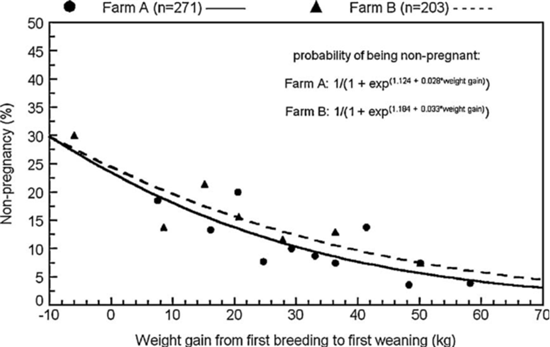
对于A场来说,妊娠失败比例的下降与断奶时体重更高有关(OR = 0.76 / 10 kg;(P = 0.03),妊娠失败比例的升高与第一个哺乳期的体重损失有关(OR = 1.79 / 10 kg;P = 0.001)。妊娠失败也与相对体重下降有关,与哺乳期体重损失低于15%的母猪相比,体重损失超过15%的母猪妊娠失败的比例会增加(OR = 2.82, P = 0.02)。经过多变量分析后,模型中只保留了从初配到第一次断奶期间体重增加的母猪。B场,就母猪品系而言,纯种荷兰长白猪的妊娠失败比例为24.5%,而杂交母猪(Y×DL)的妊娠失败比例为14.2% (OR = 1.96;P = 0.001)。初配体重越高,妊娠失败比例就越高(OR = 1.39 / 10公斤;P = 0.015)。与5天的断奶到配种间隔相比(10.9%; OR= 3.39; P = 0.001),6-20天的断奶至配种间隔也会造成妊娠失败比例增加(29.2%)。季节也影响分娩率,因为与冬季分娩和配种相比,夏季分娩和配种的母猪其妊娠失败的比例会增加(夏季:25.0%,OR= 2.76;P = 0.001,冬季:23.8%,OR= 2.97;P = 0.001)。经过多变量分析后,模型中只保留了从初配到第一次断奶期间体重增加的母猪。
For farm A, higher weight at first weaning was associated with a decreased percentage of non-pregnancy (OR = 0.76 per 10 kg; P = 0.03), whilst weight loss during first lactation was associated with an increased percentage of non-pregnancy (OR = 1.79 per 10 kg; P = 0.001). Relative weight loss was also associated with non-pregnancy, sows losing more than 15% of their weight during lactation had an increased percentage of non-pregnancy compared to sows losing less than 15% of their weight (OR = 2.82, P = 0.02). After a multivariable analysis only weight gain from first insemination to first weaning remained in the model. For farm B, sow line was associated with 24.5% nonpregnancy in Dutch Landrace compared with 14.2% in the crossbreed (Y×DL) (OR = 1.96; P = 0.001). Higher weight at first insemination was associated with higher percentage of non-pregnancy (OR = 1.39 per 10 kg; P = 0.015). A weaning to insemination interval of 6–20 days was associated with an increased percentage of non-pregnancy (29.2%) compared with a WII of 5 days (10.9%; OR= 3.39; P = 0.001). Season also affected farrowing rate, since both farrowing and being bred in summer compared with winter were associated with an increased percentage of nonpregnancy (respectively 25.0%, OR= 2.76; P = 0.001 and 23.8%, OR= 2.97; P = 0.001). After a multivariable analysis only weight gain from first insemination to first weaning remained in the model.
3
结果 Results
3.4. 影响二胎总产仔数的因素
Factors associated with total number born in second parity (TNB2)
A场有11个解释变量可以进行多变量分析,但由于相关性高,其中的5个变量未被纳入分析;第一胎断奶仔猪数与第一胎总产仔数相关(r = 0.57,表1),初配到第一次断奶的增重与妊娠期体重差、分娩后体重、哺乳期体重损失和断奶时体重相关(resp., r = 0.55, 0.49, −0.50 and 0.85, Table 1)。因此,多变量模型最初用了6个变量进行分析,即:第一胎的总产仔数(TNB1)、初配到第一次断奶期间的体重增加、初配日龄、初配体重、二胎配种的季节和二胎断奶到配种的间隔(WII2)。最终模型使用了3个相互作用不显著的变量,即第一胎的总产仔数(TNB1)、初配到第一次断奶期间的体重增加和二胎断奶到配种的间隔(WII2) (表6,R2 = 0.08)。第一胎产仔数每增加1头,二胎总产仔数TNB2增加0.18头(P = 0.04)。初配到第一次断奶期间体重每增加10公斤体重,二胎总产仔数TNB2增加0.42头(P = 0.008)。二胎断奶到配种间隔21天以上的母猪比间隔6-20天的母猪TNB2更高(P = 0.08),分别为12.5头和10.9头。
For farm A 11 explanatory variables were eligible for multivariable analysis, however due to high correlations 5 variables were not included; number of piglets weaned in first parity was correlated with total number of piglets born in first parity (r = 0.57, Table 1), weight gain from first insemination to first weaning was correlated with weight difference during pregnancy, weight after farrowing, weight loss during lactation and weight at weaning (resp., r = 0.55, 0.49, −0.50 and 0.85, Table 1). The multivariable model, therefore, started with 6 variables; total number of piglets born in first parity (TNB1), weight gain from first insemination to first weaning, weight at first insemination, age at first insemination, season of insemination in 2nd parity and weaning to insemination interval in second parity (WII2). The final model contained 3 variables with no significant interaction effects; TNB1, weight gain from first insemination to first weaning and WII2 (Table 6, R2 = 0.08). For every piglet born in first parity TNB2 increased with 0.18 piglet (P = 0.04). Per 10 kg higher weight gain from first insemination to first weaning TNB2 increases with 0.42 piglet (P = 0.008). Sows with a WII2 of more than 21 days tended (P = 0.08) to have higher TNB2 compared with sows with a WII2 of 6–20 days (resp. 12.5 vs. 10.9 piglet).
表 6:二胎产仔数的影响因素:连续变量的多变量模型估计和类变量的最小二乘均值(LSMeans)。
Table 6: Effects on total number of piglets born in second parity: multivariable model estimates for continuous variables and least square means (LSMeans) for class variables.
For farm A, higher weight at first weaning was associated with a decreased percentage of non-pregnancy (OR = 0.76 per 10 kg; P = 0.03), whilst weight loss during first lactation was associated with an increased percentage of non-pregnancy (OR = 1.79 per 10 kg; P = 0.001). Relative weight loss was also associated with non-pregnancy, sows losing more than 15% of their weight during lactation had an increased percentage of non-pregnancy compared to sows losing less than 15% of their weight (OR = 2.82, P = 0.02). After a multivariable analysis only weight gain from first insemination to first weaning remained in the model. For farm B, sow line was associated with 24.5% nonpregnancy in Dutch Landrace compared with 14.2% in the crossbreed (Y×DL) (OR = 1.96; P = 0.001). Higher weight at first insemination was associated with higher percentage of non-pregnancy (OR = 1.39 per 10 kg; P = 0.015). A weaning to insemination interval of 6–20 days was associated with an increased percentage of non-pregnancy (29.2%) compared with a WII of 5 days (10.9%; OR= 3.39; P = 0.001). Season also affected farrowing rate, since both farrowing and being bred in summer compared with winter were associated with an increased percentage of nonpregnancy (respectively 25.0%, OR= 2.76; P = 0.001 and 23.8%, OR= 2.97; P = 0.001). After a multivariable analysis only weight gain from first insemination to first weaning remained in the model.
3
结果 Results
3.4. 影响二胎总产仔数的因素
Factors associated with total number born in second parity (TNB2)
A场有11个解释变量可以进行多变量分析,但由于相关性高,其中的5个变量未被纳入分析;第一胎断奶仔猪数与第一胎总产仔数相关(r = 0.57,表1),初配到第一次断奶的增重与妊娠期体重差、分娩后体重、哺乳期体重损失和断奶时体重相关(resp., r = 0.55, 0.49, −0.50 and 0.85, Table 1)。因此,多变量模型最初用了6个变量进行分析,即:第一胎的总产仔数(TNB1)、初配到第一次断奶期间的体重增加、初配日龄、初配体重、二胎配种的季节和二胎断奶到配种的间隔(WII2)。最终模型使用了3个相互作用不显著的变量,即第一胎的总产仔数(TNB1)、初配到第一次断奶期间的体重增加和二胎断奶到配种的间隔(WII2) (表6,R2 = 0.08)。第一胎产仔数每增加1头,二胎总产仔数TNB2增加0.18头(P = 0.04)。初配到第一次断奶期间体重每增加10公斤体重,二胎总产仔数TNB2增加0.42头(P = 0.008)。二胎断奶到配种间隔21天以上的母猪比间隔6-20天的母猪TNB2更高(P = 0.08),分别为12.5头和10.9头。
For farm A 11 explanatory variables were eligible for multivariable analysis, however due to high correlations 5 variables were not included; number of piglets weaned in first parity was correlated with total number of piglets born in first parity (r = 0.57, Table 1), weight gain from first insemination to first weaning was correlated with weight difference during pregnancy, weight after farrowing, weight loss during lactation and weight at weaning (resp., r = 0.55, 0.49, −0.50 and 0.85, Table 1). The multivariable model, therefore, started with 6 variables; total number of piglets born in first parity (TNB1), weight gain from first insemination to first weaning, weight at first insemination, age at first insemination, season of insemination in 2nd parity and weaning to insemination interval in second parity (WII2). The final model contained 3 variables with no significant interaction effects; TNB1, weight gain from first insemination to first weaning and WII2 (Table 6, R2 = 0.08). For every piglet born in first parity TNB2 increased with 0.18 piglet (P = 0.04). Per 10 kg higher weight gain from first insemination to first weaning TNB2 increases with 0.42 piglet (P = 0.008). Sows with a WII2 of more than 21 days tended (P = 0.08) to have higher TNB2 compared with sows with a WII2 of 6–20 days (resp. 12.5 vs. 10.9 piglet).
表 6:二胎产仔数的影响因素:连续变量的多变量模型估计和类变量的最小二乘均值(LSMeans)。
Table 6: Effects on total number of piglets born in second parity: multivariable model estimates for continuous variables and least square means (LSMeans) for class variables.
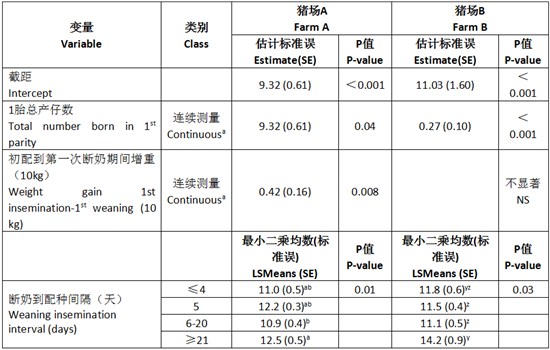
NS: 不显著。
ab列内不同的上标趋于表明差异显著(P < 0.10);
yz列内不同上标表示差异显著(P < 0.05)
R2模型A猪场为0.08,B猪场为0.11。
NS = not significant.
ab different superscripts within columns tend to indicate significant differences (P < 0.10)
yz different superscripts within columns indicate significant differences (P < 0.05)
R2 model 0.08 for farm A and 0.11 for farm B.
B场也有11个解释变量符合多变量分析的条件,但由于相关性高,有4个变量没有纳入分析;初配体重与第一次分娩后体重相关(r = 0.52,表1),初配到第一次断奶期间增重与哺乳期体重损失和断奶体重相关(resp., r =−0.63, 0.74, 表1)。因此,多变量模型最初只用了7个变量,即:一胎总产仔数TNB1、初配到第一次断奶期间体重的增重、初配日龄、第一次分娩后体重、第一胎断奶仔猪数、第二胎配种季节和第二胎断奶到配种间隔WII2。最终模型只用了2个变量,即TNB1和WII2(表6,R2 = 0.11)。第一胎产仔数每增加1头,二胎总产仔数TNB2增加0.27头。二胎断奶到配种间隔21天以上的母猪比间隔5天和6-20天的母猪TNB2更高,分别为14.2头,11.5头和11.1头。
For farm B also 11 explanatory variables were eligible for multivariable analysis, however due to high correlations 4 variables were not included; weight at first breeding was correlated with weight after 1st farrowing (r = 0.52, Table 1), weight gain from first insemination to first weaning were correlated with weight loss during lactation and weight at weaning (resp., r =−0.63, 0.74, Table 1). The multivariable model therefore started with 7 variables; TNB1, weight gain from first insemination to first weaning, age at first insemination, weight after 1st farrowing, number of piglets weaned in 1st parity, season of insemination in 2nd parity and WII2. The final model contained 2 variables; TNB1 and WII2 (Table 6, R2 = 0.11). For every extra piglet born in first parity TNB increased with 0.27 piglet in second parity. Sows with a WII2 of more than 21 days had more piglets in second parity compared to sows with aWII2 of 5 or 6–20 days (resp. 14.2, 11.5 and 11.1 TNB2). Interaction was not significant.
未完待续
To be continued…
ab列内不同的上标趋于表明差异显著(P < 0.10);
yz列内不同上标表示差异显著(P < 0.05)
R2模型A猪场为0.08,B猪场为0.11。
NS = not significant.
ab different superscripts within columns tend to indicate significant differences (P < 0.10)
yz different superscripts within columns indicate significant differences (P < 0.05)
R2 model 0.08 for farm A and 0.11 for farm B.
B场也有11个解释变量符合多变量分析的条件,但由于相关性高,有4个变量没有纳入分析;初配体重与第一次分娩后体重相关(r = 0.52,表1),初配到第一次断奶期间增重与哺乳期体重损失和断奶体重相关(resp., r =−0.63, 0.74, 表1)。因此,多变量模型最初只用了7个变量,即:一胎总产仔数TNB1、初配到第一次断奶期间体重的增重、初配日龄、第一次分娩后体重、第一胎断奶仔猪数、第二胎配种季节和第二胎断奶到配种间隔WII2。最终模型只用了2个变量,即TNB1和WII2(表6,R2 = 0.11)。第一胎产仔数每增加1头,二胎总产仔数TNB2增加0.27头。二胎断奶到配种间隔21天以上的母猪比间隔5天和6-20天的母猪TNB2更高,分别为14.2头,11.5头和11.1头。
For farm B also 11 explanatory variables were eligible for multivariable analysis, however due to high correlations 4 variables were not included; weight at first breeding was correlated with weight after 1st farrowing (r = 0.52, Table 1), weight gain from first insemination to first weaning were correlated with weight loss during lactation and weight at weaning (resp., r =−0.63, 0.74, Table 1). The multivariable model therefore started with 7 variables; TNB1, weight gain from first insemination to first weaning, age at first insemination, weight after 1st farrowing, number of piglets weaned in 1st parity, season of insemination in 2nd parity and WII2. The final model contained 2 variables; TNB1 and WII2 (Table 6, R2 = 0.11). For every extra piglet born in first parity TNB increased with 0.27 piglet in second parity. Sows with a WII2 of more than 21 days had more piglets in second parity compared to sows with aWII2 of 5 or 6–20 days (resp. 14.2, 11.5 and 11.1 TNB2). Interaction was not significant.
未完待续
To be continued…
















